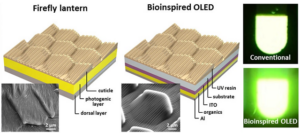Scientists have replicated the patterns of a firefly’s wing to create a more efficient OLED light.
Fireflies emit the most bio-luminescent light of any creature – largely due to the optical properties of the light-emitting cuticle, which is patterned with small hierarchical structures, Man-made lights, by contrast, are smooth.
Led by Ki-Hun Jeong at the Korea Advanced Institute of Science and Technology (KAIST), the team examined the hierarchical structures, which are described as ” inclined microstructures, with nanostructures existing on the cuticular ultrastructures of a firefly’s lantern.” The function of asymmetric and hierarchical structures contributes to the efficiency of a firefly’s light.
Previous research, some by the same authors, has shown that the structures on firefly cuticles improve light transmission by reducing internal reflection – increasing the amount of light that exits the animal. Internal reflection is a significant challenge for LEDs, where more than half of the light produced can be reflected back into the device, rather than being emitted.
The new study has shown that the asymmetric and hierarchical nature of the cuticle structures also plays a key role in fireflies’ light-emitting ability. The researchers created precise molds of these structures to use as the optical layer of an OLED. The result was a 60% increase in light extraction efficiency and a 15% wider angle of illumination.
Jeong and his team are now looking for an industrial OLED partner who is interested in commercialising their idea.

